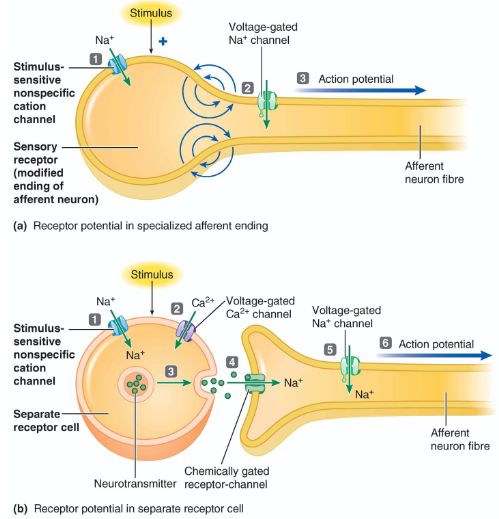Afferent division - receptor physiology
1/12
There's no tags or description
Looks like no tags are added yet.
Name | Mastery | Learn | Test | Matching | Spaced |
|---|
No study sessions yet.
13 Terms
what makes up the afferent division of the PNS?
sensory stimuli (external stimuli - touch, pain) and visceral stimuli (outside of CNS, inside of body - blood pressure, temperature)
compare somatosensory and special senses receptors (location, type of info collected)
somatosensory receptors: info from surface of body (soma), not specialized, because they are just free nerve endings of afferent neurons
special sense receptors: completely different cell (ex: rods and cones for the special sight of vision)
what is the adequate stimulus of a receptor?
adequate stimulus = the type of energy (light, heat, soundwaves) that the cell is best at detecting - this is what specializes a receptor!
give example of cells that can detect multiple types of energy
rods and cones - best at detecting light, but also detect mechanical touch (pushing on eyeball) - which is perceived as light
what encodes the modality of proprioception?
the receptor and the adequate stimulus
what is the adequate stimulus for each of the following types of receptors?
photoreceptors = light
thermoreceptors = heat
chemoreceptors = chemicals
mechanoreceptors = mechanical energy (stretch, pressure, vibration) - convey tactile responses
compare generator potentials and receptor potentials
generator potentials:
specialized afferent ending (modified ending of afferent nerve)
stimulus sensitive nonspecific cation channels that let in ions
VG Na+ channels that cause graded potential and generate action potential
receptor potentials
separate receptor cell that have stimulus sensitive nonspecific cation channel which activates VG Na+ channels, which move in Na+ and depolarize
change in voltage activates Ca+ channels, and their influx causes release of NT
NT then move to afferent fiber, activating Na+ channels, and cause firing of neurons

Compare phasic vs tonic receptors in terms of adaptation and give example of each
phasic receptors: adapt rapidly (at this point, no longer send stimuli to CNS), and have off response. Ex: tactile receptors in the skin
tonic receptors: slow or no adaptation, provide constant info about a stimuli (ex: pain receptors)
speak to the different “labelled lines” in the somatosensory pathway
1st order sensory neuron: either afferent neuron with specialized ending, or neuron close to special sense receptor
2nd order: takes sensory info to thalamus for crude perception of sense
3rd order: takes crude info from thalamus and projects it to somatosensory cortex, specifically the area where that sense is processed
how is intensity of stimulus conveyed?
either by the number of receptors activated (the more activated, the more info conveyed) and/or the frequency of firing of a given receptor
what is a receptive field?
receptive field: the area around a receptor where stimuli are detected
How does the size of receptive field determine the accuracy of info from that point in the body?
give analogy
the smaller the receptive field, the more you have, meaning the greater the accuracy and amount of info from that region and the fine touch perception(compare fingers to elbow)
analogy: monitoring how many spiders cross the floor in class vs the floor in the gym
what helps the brain localize where the signal is coming from?
lateral inhibition - areas immediately around initial stimulus are inhibited, which enhances signals coming from small spot